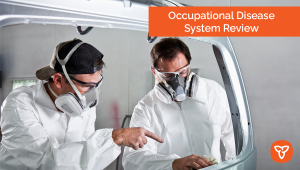
Launching the First-Ever Review of Occupational Illnesses
The Ontario government is working for workers by launching the first-ever review of the province’s occupational illness system. Conducted by the MAP Centre for Urban Health Solutions at St. Michael’s Hospital in Toronto, an independent research centre with expertise in studying complex community health issues, the review will evaluate how occupational illnesses in Ontario are identified, monitored, and prevented. The review will deliver lasting change for injured workers and their families.
“Our government has a workers-first plan to build stronger families, stronger communities and a future where no one is left behind,” said Monte McNaughton, Minister of Labour, Training and Skills Development. "Ontario has one of the strongest health and safety records in the country, but we need to make sure our system works for everyone. I have tasked this team of independent experts to find a clear path forward that improves supports for injured workers and their families. Change is coming to the system, and we are going to get it done."
In February, Minister McNaughton formally recognized Parkinson’s Disease as an occupational disease linked to work-related McIntyre Powder exposure leading to faster injury compensation claims for workers and their families.
“As science advances and our understanding of occupational disease evolves, we need to make sure our systems of support keep up,” says Jeffery Lang, President and CEO of the WSIB. “It is crystal clear we need everyone involved in the occupational disease system to work together to prevent illnesses in the first place, and properly identify them when they do happen.”
The system-wide study, expected in December of this year, will focus on finding and fixing roadblocks and complexities that were identified by Dr. Paul Demers in the 2020 independent review of occupational disease. This could lead to more timely compensation and better recognize work related illnesses. The research team will consult with health and safety system partners including labour groups and workers’ rights advocates, employers, health care professionals and the health and safety community.
Today’s announcement builds on the government’s ambitious plan to support, protect and attract workers by making the province the best place to live, work and raise a family. This includes introducing new legislation that increases the maximum fines for businesses that fail to protect their workers and releasing Ontario’s five-year Prevention Works strategy. The strategy aims to help workplaces comply with and exceed workplace health and safety laws and standards to keep workers safe, focusing on occupational illnesses, employee mental health, workplace violence, and harassment.
Quick Facts
- The Ontario government and the WSIB are partnering to launch the first-ever review of the province’s occupational illness system.
- An occupational illness is a condition that results from exposure to a physical, chemical, or biological agent in the workplace to the extent that the normal physiological mechanisms are affected and the health of the worker is impaired.
- According to the Association of Worker’s Compensation Boards of Canada, Ontario’s occupational health and safety record is among the best in Canada, with the province achieving the lowest rate of work time lost to injury among any province or territory since 2009.
- The WSIB is an independent agency that provides loss of earnings and other benefits to workers and their survivors, health care, and assists in early, safe return to work for workers injured on the job or made ill by an occupational disease.
- In support of Dr. Demers’ report, Using Scientific Evidence and Principles to Help Determine the Work-Relatedness of Cancer, the WSIB recently established a new scientific advisory table for occupational disease to guide their decision making.
- Ontario recently invested more than $6 million to support research led by the Occupational Cancer Research Centre (OCRC) to identify the causes of workplace cancers, prevent them from occurring, and better support workers already impacted by occupational illness.
